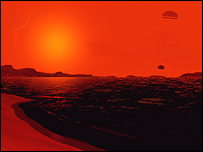The height of the waves may reach up to 7 times that of the Earth but they will move much slower and be very far apart

Drawing showing the Huygens spacecraft landing on Titan
Scientists have succeeded in developing weather forecasts for the oily oceans of Titan, Saturn's largest moon and the target of a spacecraft landing next year. The researchers gathered at the annual meeting of the British Astronomical Union made a comparison between the oceans on Titan and those on Earth.
The height of the waves may reach up to 7 times that of the Earth but they will move much slower and will be very far apart, they believe.
In January 2005, we will know if we were right or wrong when the Huygens spacecraft beats on Titan. The European spacecraft is currently carried by the American Cassini spacecraft that will explore the entire Saturn system.
Huygens will plummet through Titan's nebulous atmosphere but astronomers don't know what it will find.
If there's an ocean there, then scientists know what to expect, so a team from Britain's Open University, British satellite company Surrey and the Oceanographic Center in Southampton developed a computer simulation to predict how the wind-driven waves on the distant moon would behave.
Since the first flyby of Titan by the Voyager 1 spacecraft in 1980, researchers have believed that Titan's surface may be covered in days of ethane or methane.
Radar signals returned from Saturn's moon reinforced the idea of oily oceans. The researchers used the huge radio telescope at Arecibo and analyzed the echoes from Titan. They concluded that 75 percent of the Moon's surface may be covered by an open body of liquid hydrocarbons.
The precise nature of the returned signals can be used to assess the nature of the fluid mass's fragmentation. The indications that the slope of the waves does not exceed four degrees - a fact that the latest simulations reinforce.
"We hope that Huygens will indeed put an end to the speculation," said Dr. Nadeem Jaapour of Suri-Technologies satellites.
Not only will this be the furthest soft landing of a spacecraft ever made but Huygens may be the first extraterrestrial vessel to sail a hydrocarbon sea.
Titan - the moon of Saturn
ID
Titan is the second largest moon in the solar system, only the fair moon Ganymede is larger; It is the only moon in the solar system that has a compressed atmosphere; It always shows the same side to Saturn as it orbits the planet; Lakes of liquid ethane and methane may cover the surface; It is possible that the spacecraft will land in an ocean of hydrocarbons or on an ice surface.

One response
I can't believe there is water there, what beauty, what happened in the end with it?